Designing lighting for a skate park must take into account both the environment and the level of skateboarding competition. For instance, an outdoor setup featuring ramps and extensions could serve as the ideal venue for hosting prestigious international events like the SLS World Tour Championships. On the other hand, events like the Red Bull Cornerstone often draw top skaters to indoor locations, unlike The Vans Park Series.
In an indoor skating arena, relying on natural sunlight for optimal lighting is not an option. As the level of competition continues to rise each year, facility owners with outdated lighting systems need to upgrade to LED solutions to keep pace with the latest tricks and the advanced skills of professional skaters. Even in public parks, it is essential to provide sufficient illuminance for every pipe or wedge to ensure safety and enjoyment for recreational users.
This guide will explore the essential elements of lighting design and layout for both indoor and outdoor skate parks.
Table of Contents
ToggleLighting Options for Skate Parks
Flood Lights and Spot Lights
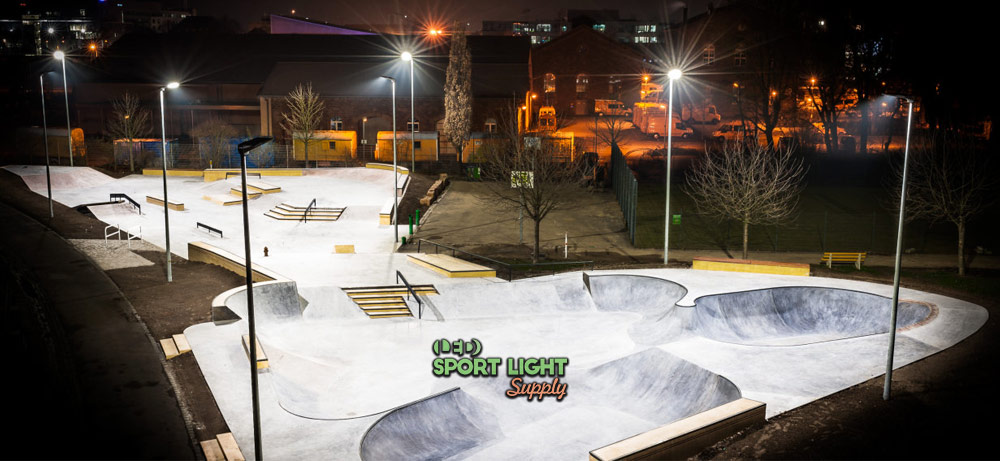
The primary lighting source in a skate park is typically the standard flood light, a versatile LED fixture designed for sports lighting. These can be installed on high masts or walls and are ideal for providing broad, uniform illumination across the skate park. The flood light’s main components include a lens, optical glass, LED chips, and a heat sink, all encased in a durable housing. The wires inside the casing are connected to a driver, which is a power supply that converts AC power to DC. It’s important to note that not all models come with a driver, making this a crucial detail for lighting designers.
The key difference between flood lights and spot lights lies in their intended use. Flood lights are best for illuminating short-range areas such as ramps, while spot lights are more suited for targeting distant areas due to their highly focused luminous flux.
| Component | Function |
|---|---|
| Lens | Directs light into desired angles |
| Optical Glass | Protects LED chips from the environment |
| LED Chips | Emits the light source |
| Heat Sink | Dissipates heat generated by the LEDs |
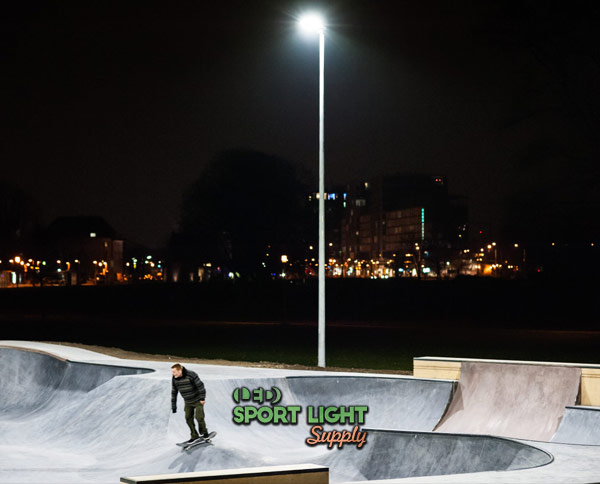
High Mast Lights
High mast lights are powerful fixtures designed for large outdoor skate parks. Depending on the location of the light pole, these fixtures may take the form of a ring of LED spot lights, a group of multiple LED lights, or a single flood light. The height of the high mast is a significant factor influencing the lighting design, as it determines the spread and intensity of the light.
High mast lighting in skate parks often mirrors the setup of street lighting in public parks. However, in larger skate parks, these lights might be used to provide vertical illuminance or horizontal uniformity, particularly in deeper areas like pools. While primarily used outdoors, high mast lights can sometimes be adapted for indoor use depending on the layout and design of the skate park.
Compliance with lux requirements is essential for high mast lighting, meaning that many LED lights used in these fixtures can be suitable for both indoor and outdoor designs. The main differences typically lie in the bracket or support system, although some high mast lights may be too bright for indoor use.
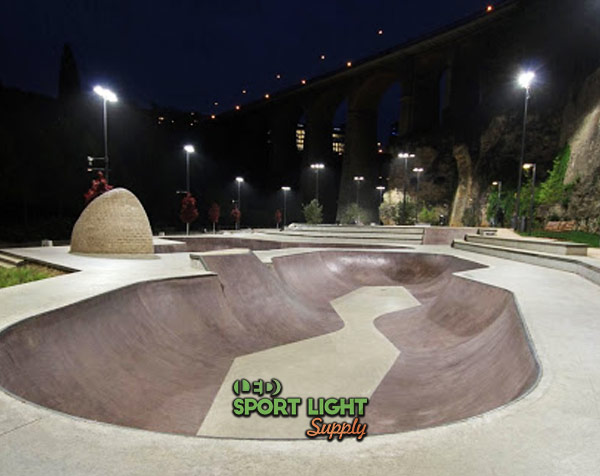
Solar Lights
Recent advancements in LED technology have made it possible to use solar lights as a practical solution for skate parks, particularly in outdoor settings. These lights are stand-alone fixtures that do not require a connection to the power grid, making them easy to install and cost-effective. As long as the solar panel receives direct sunlight for at least eight hours per day, these lights can provide sufficient brightness for training and recreational activities.
Solar lights are designed exclusively for outdoor use and are often used to provide secondary lighting in public parks adjacent to skate parks or to illuminate pathways between ramps and pipes to prevent injuries at night.
| Type of Solar Light | Application |
|---|---|
| Centralized Solar Street Light System | General illumination of large areas |
| Decorative Lamps | Aesthetic lighting for public spaces |
| Flood Lights | Bright, broad coverage for skate areas |
| Pathway Lights | Illuminating walkways and paths |
| String Lights | Ambient lighting for aesthetic purposes |
RGB Lights
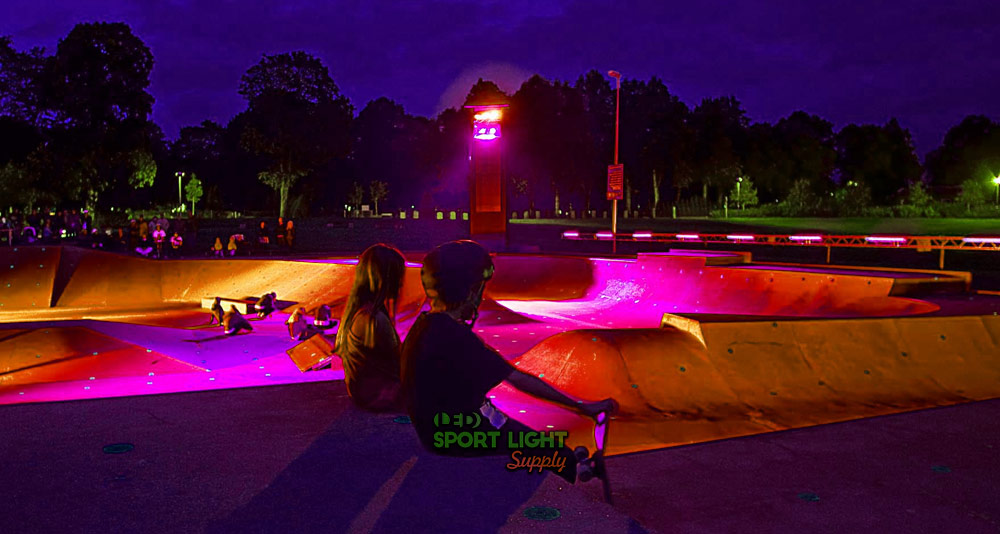
RGB lights are color-changing fixtures suitable for both outdoor and indoor skate parks. These lights allow skate park owners to create dynamic, colorful ambient lighting through remote control systems, often using an app with Bluetooth connectivity. RGB lights can transform a regular skate park into a visually striking environment, making it a unique playpark.
The luminaire design of RGB lights impacts their usability. Some models cycle through different colors and offer various brightness settings, while others might include hue bars for additional visual effects. Hue bars, in particular, emit intense, bright light that spreads more effectively than standard LED strips, enhancing the visibility and aesthetic appeal of the skate park.
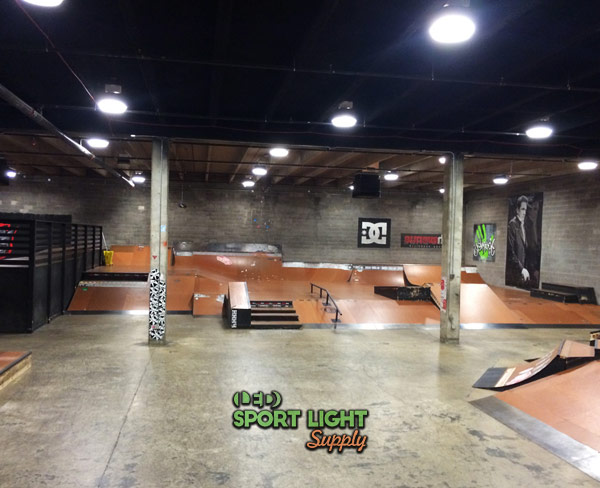
High Bay Lights
High bay lights are designed specifically for indoor skate parks. These fixtures typically have a UFO shape that directs light downward vertically, making them ideal for providing focused illumination over specific areas. High bay lights are lightweight compared to other LED fixtures but generally have a lower power consumption, usually not exceeding 200W.
In most cases, high bay lights are installed in groups to achieve the desired lighting levels. From a design perspective, they offer the best solution for a direct lighting approach, ensuring that every trick and transition is well-lit. These lights are also dimmable and come with various customization options.
The UFO design of high bay lights facilitates efficient heat dissipation, and newer models offer a range of beam angles for greater control and flexibility. High bay lights are among the most cost-effective and efficient LED light sources for both sports facilities and skate park arenas.
Skate Park Lighting Design for Indoor and Outdoor Use
Lux Requirements for Skate Park Lighting
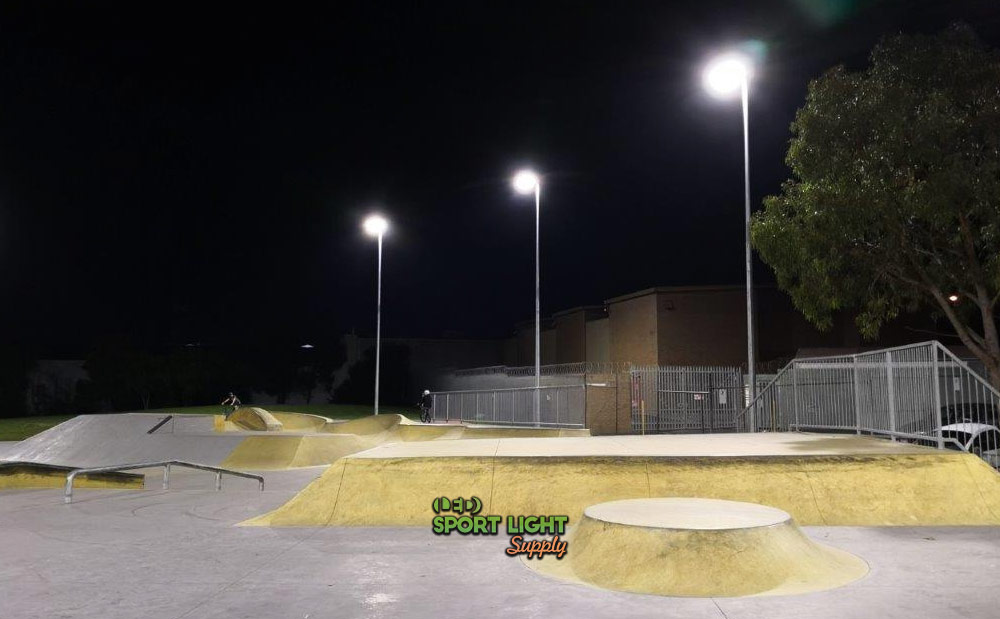
The primary objective of skate park lighting design is to ensure adequate brightness for safety and visual comfort. The lux requirement is a key metric in this process, measuring the amount of light that falls on the skate park surface. Lux, a unit of light intensity, is measured using a light meter to ensure that each vert ramp and pool receives sufficient illuminance.
The lux requirements vary depending on the level of skateboarding competition, with three classes typically defined:
| Class | Description | Indoor Lux Requirement | Outdoor Lux Requirement |
|---|---|---|---|
| Class I | International and televised competitions | At least 1,000 lux | 750 lux |
| Class II | Local and regional, non-televised competitions | 500-800 lux | 500 lux |
| Class III | Training and recreational use | 200-400 lux | 200 lux |
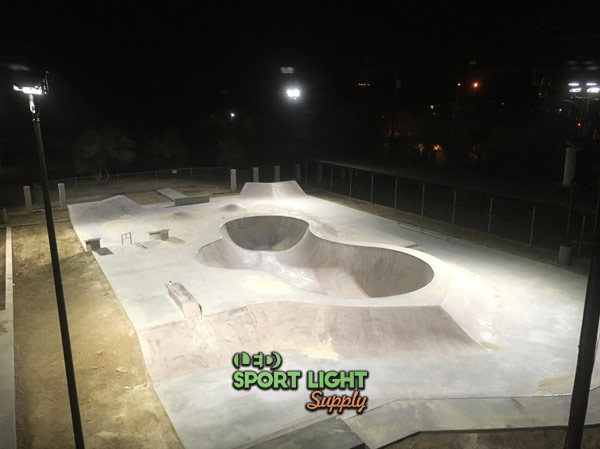
Lighting Uniformity
Lighting uniformity is crucial to ensure that all areas of the skate park receive a consistent light intensity, preventing skaters from being blinded by sudden changes in brightness. Uniform lighting helps skaters navigate the park safely and comfortably.
Lighting uniformity is calculated by dividing the lowest lux reading by the maximum value or the mean average across the skate park. The required uniformity levels differ by competition class:
| Class | Uniformity Requirement |
|---|---|
| Class I | 0.7 |
| Class II | 0.7 |
| Class III | 0.4 |
Color Temperature
The color temperature of lighting significantly impacts the visual experience in a skate park. Most LED lights offer various color temperatures, measured in Kelvin (K). This value describes the hue emitted by the light source:
| Light Source | Color Temperature (K) | Description |
|---|---|---|
| Sunlight | ~5,000 K | Neutral white light |
| Metal Halides | 6,000-7,000 K | Bluish light |
| Halogen Bulbs | ~3,000 K | Yellowish glow |
| LEDs (Skate Park Use) | 5,000-5,500 K | Neutral white preferred by skaters; cool white may be requested by broadcasters |
LED vs. Metal Halide vs. Mercury Vapor
Comparing different light sources helps in choosing the most suitable option for skate parks. LEDs offer significant advantages over traditional lighting options like metal halide and mercury vapor lamps.
| Light Source | Lifespan | Concerns | Advantages |
|---|---|---|---|
| Metal Halide | Short | Overheating, high energy consumption, requires frequent maintenance | Provides bright, high-intensity light that is effective for large outdoor spaces |
| Mercury Vapor | Short | Harmful UV rays, overheating, fire hazard, potential environmental issues due to mercury content | Offers long-range illumination and a strong bluish hue that can enhance visibility in some applications |
| Halogen | Shortest | Short lifespan, high energy consumption, generates significant heat, can cause glare | Instant-on capability, with warm light that closely mimics natural sunlight |
| LED | 50,000 hours | Potential for higher upfront cost, may require proper heat dissipation mechanisms to ensure longevity | Long lifespan, energy-efficient, no toxic materials, minimal heat output, excellent color rendering, adaptable to various designs and environments |
Glare-Free Lighting
Glare-free lighting is a critical innovation in modern skate park lighting design. These lights use sensors or specific optics to reduce light intensity and direct the luminous flux appropriately, enhancing visibility while minimizing glare.
| Glare-Free Lighting Features | Benefits |
|---|---|
| Sensors for directional control | Reduces glare, enhances visibility |
| Special optics and shields | Minimizes light intensity, improves safety |
These fixtures are especially beneficial for high mast lighting and large ramps such as mega ramps or deep pools, where clear visibility is paramount for the safety of professional skaters.
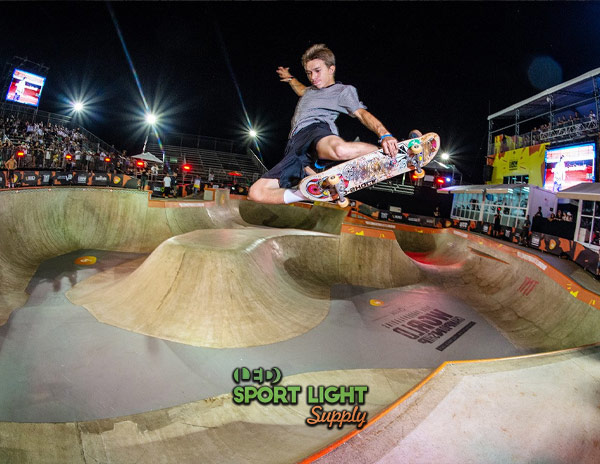
CRI and TLCI Standards
The quality of light in a skate park is measured using the Color Rendering Index (CRI) and Television Lighting Consistency Index (TLCI). These standards assess how accurately a light source renders colors:
| Standard | Purpose | Requirement |
|---|---|---|
| CRI | Evaluates color accuracy for the human eye | 85 Ra for outdoor night activities |
| TLCI | Assesses color accuracy for cameras | 90+ for televised events |
Both CRI and TLCI are essential for ensuring that colors are rendered accurately, whether for live events or televised broadcasts.
Waterproof Insulation
In outdoor skate parks, waterproof lighting systems are essential to protect against weather elements. Waterproof protection ensures that lights continue to function safely and effectively even in wet conditions:
| IP Rating | Protection Level | Recommended Use |
|---|---|---|
| IP65 | Protects against water jets | Standard outdoor use |
| IP67 | Protects against immersion up to 1 meter | Highly exposed areas |
| IP68 | Protects against prolonged immersion | Areas prone to heavy rain |
The choice of IP rating depends on the exposure of the lights to moisture and the specific location within the skate park.
Lighting Layout for Outdoor Skate Parks
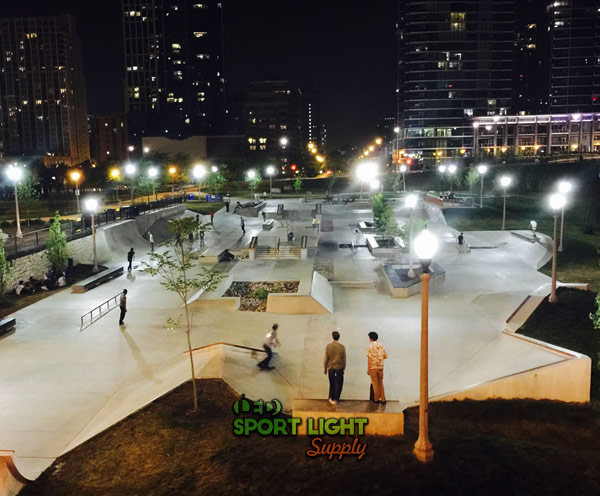
Light Pole Height
In outdoor skate parks, selecting the appropriate light pole height is crucial. A balance must be struck between providing adequate lighting and minimizing potential disturbances to nearby residents, drivers, and the natural environment. Shorter poles often deliver sharper illumination, which can highlight details more effectively but may also cause glare if not properly managed. Conversely, taller poles can cover a larger area, though they may result in lower lux values, leading to light loss and potentially increasing the need for additional poles.
Generally, pole heights range between 8 and 20 feet. Taller poles reduce the number of fixtures required, potentially lowering installation and maintenance costs. However, shorter poles offer more focused lighting, which might require additional measures to control brightness and prevent glare. The choice of pole height should consider both technical requirements and the impact on the surrounding environment.
Pole Locations
The location of light poles in a skate park is another essential aspect of the lighting layout. The goal is to create an efficient design that provides adequate illumination without unnecessary fixtures. Proper placement reduces light pollution and enhances the overall experience for park users. LED lights are particularly useful in outdoor skate parks, offering both long-range and short-range illumination. However, the layout must be carefully planned to accommodate the park’s unique features, such as ramps, hips, and cradles.
Modern lighting design tools, including photometric analysis, enable designers to create custom layouts that consider the park’s specific dimensions and safety requirements. The size and width of ramps, in particular, play a significant role in determining the placement of high mast poles, ensuring both effective lighting and the safety of skaters.
Distance Between Light Poles and Skate Park Features
The distance between light poles and skate park features, such as pipes and ramps, is critical to achieving optimal lighting conditions. Proper spacing is essential to avoid shadows, which can pose a significant safety risk. For example, when a skater navigates a full pipe or attempts to go over-vert, shadows can obscure their view and increase the likelihood of accidents.
The ideal distance ensures that the light provides uniform illumination across the entire ramp or pipe, minimizing the formation of shadows. However, if the light is too close to the feature, it can create harsh contrasts, leading to uneven lighting. A well-conducted photometric analysis helps determine the best pole placement, ensuring both the required lighting levels and adherence to safety standards.
Indoor Skate Park Lighting Layout
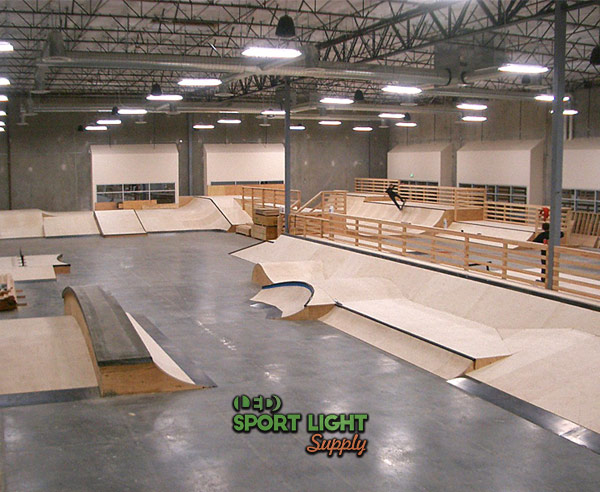
Ceiling Height
In indoor skate parks, the height at which high bay lights are installed plays a significant role in the effectiveness of the lighting. The ceiling height is a critical factor, as it determines the appropriate height for hanging the lights. In some cases, skateboard bowls embedded into the floor may add vertical space, necessitating a photometric analysis to ensure optimal lighting coverage.
Many LED lights can be hung at heights exceeding 20 feet without issues. However, lower ceilings might require a lighting layout with more fixtures or the use of recessed lights to maintain adequate illumination. In some instances, using LED replacement bulbs for indirect lighting can enhance lighting uniformity and create a more welcoming ambiance in the skate park.
Number of High Bay Lights
The number of high bay lights needed in an indoor skate park is influenced by the ceiling height, which in turn dictates the optimal wattage of the light sources. Typical LED high-bay lights, consuming between 150-200 Watts, provide a lumen output ranging from 30,000 to 40,000 lumens.
The beam angle of the lights is another crucial factor. While many sports lights come with a fixed beam angle, newer models offer versatility, allowing for choices between a 120-degree or a 60-degree angle. Selecting the appropriate number of lights can lead to cost and time savings. However, the lighting layout may only be compatible with specific types of lamps, which is why older systems often require renovation or retrofit solutions.
Spacing Between High Bay Lights
Proper spacing between high bay lights is essential to avoid shadows on the walls or skating surface. If the lights are placed too close to the corners, reflective surfaces may cause glare, disrupting the experience for skaters. Generally, maintaining a distance of 2-3 feet from the walls is sufficient to prevent shadows and glare. However, the spacing between fixtures also affects operating costs, making it important to consult a professional lighting designer for the best solution.
A common guideline is to space each high bay light by dividing the ceiling height in half. However, this simple method may not always work with more complex ramp designs, such as Nessy, funbox, or grind box. For those with an existing evenly-spaced lighting design, adding a lighting control system can further enhance the overall effectiveness of the layout.
Conclusion
Designing skate park lighting requires balancing functionality and aesthetics, tailored to both the environment and competition level. Whether for outdoor events like the SLS World Tour Championships or indoor venues such as the Red Bull Cornerstone, effective lighting is crucial for safety and performance. Upgrading to modern LED systems ensures facilities can keep up with evolving skateboarding skills. This guide highlights essential aspects like lighting types, spacing, and uniformity to create a safe and enjoyable skate park experience.
